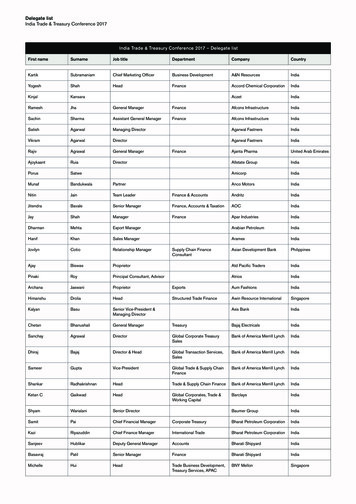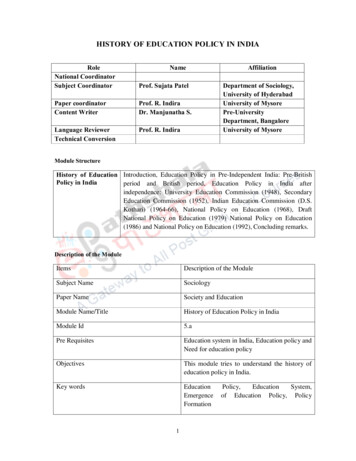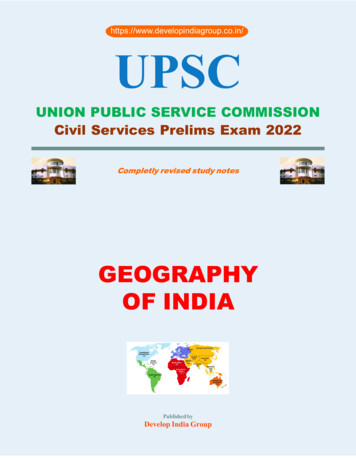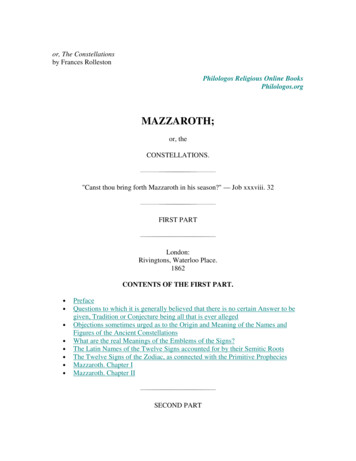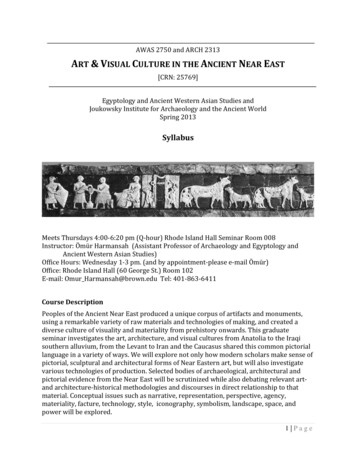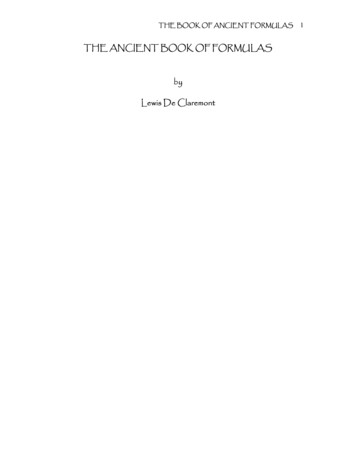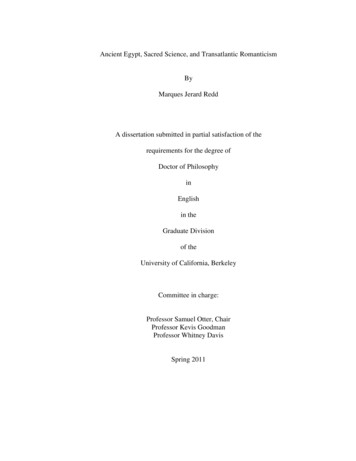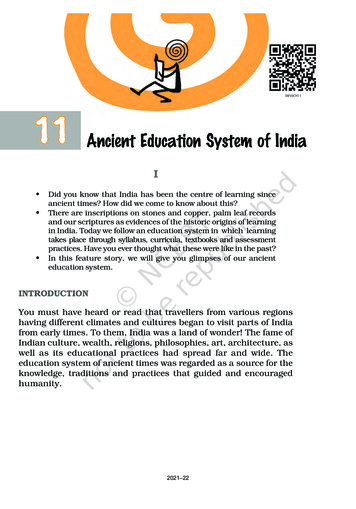
Transcription
Ancient Education System of IndiaI Did you know that India has been the centre of learning sinceancient times? How did we come to know about this?There are inscriptions on stones and copper, palm leaf recordsand our scriptures as evidences of the historic origins of learningin India. Today we follow an education system in which learningtakes place through syllabus, curricula, textbooks and assessmentpractices. Have you ever thought what these were like in the past?In this feature story, we will give you glimpses of our ancienteducation system.INTRODUCTIONYou must have heard or read that travellers from various regionshaving different climates and cultures began to visit parts of Indiafrom early times. To them, India was a land of wonder! The fame ofIndian culture, wealth, religions, philosophies, art, architecture, aswell as its educational practices had spread far and wide. Theeducation system of ancient times was regarded as a source for theknowledge, traditions and practices that guided and encouragedhumanity.2021–22
SALIENT FEATURES OF ANCIENT EDUCATION SYSTEMFrom the time of Rigveda onwards, our ancient education systemevolved over the period and focused on the holistic development ofthe individual by taking care of both the inner and the outer self.The system focused on the moral, physical, spiritual and intellectualaspects of life. It emphasised on values such as humility,truthfulness, discipline, self-reliance and respect for all creations.Students were taught to appreciate the balance between humanbeings and nature. Teaching and learning followed the tenets ofVedas and Upanishads fulfilling duties towards self, family andsociety, thus encompassing all aspects of life. Education systemfocused both on learning and physical development. In other words,the emphasis was on healthy mind and healthy body. You cansee that education in India has a heritage of being pragmatic,achievable and complementary to life.SOURCES OF EDUCATIONThe ancient system ofeducationwastheeducation of the Vedas,Brahmanas, Upanishadsand Dharmasutras. Youmust have heard thenames of Aryabhata,Panini, Katyayana andPatanjali. Their writingsand the medical treatises ofCharaka and Sushruta were A page from a manuscript* of the Rigvedaalso some of the sources of learning. Distinction was also drawn*This birch bark manuscript of the Rigveda was found in Kashmir. About 150 years ago, itwas used to prepare one of the earliest printed texts of the Rigveda, as well as an Englishtranslation. It is now preserved in a library in Pune, Maharashtra. (Class VI, Our Pasts-1,NCERT, 2017)heritage: something that is handed down from the past, as a tradition tenets: the mainprinciples of a religion or philosophy90It so happened.2021–22
between Shastras (learneddisciplines) and Kavyas(imaginative and creativeliterature). Sources of learningwere drawn from variousdisciplines such as Itihas(history), Anviksiki (logic),Mimamsa(interpretation)Shilpashastra (architecture),Visual mapping of the variousArthashastra (polity), Varta disciplines encompassed in the Vedas(agriculture, trade, commerce,animal husbandry) and Dhanurvidya (archery).Physical education too was an important curricular area andpupils participated in krida (games, recreational activities),vyayamaprakara (exercises), dhanurvidya (archery) for acquiringmartial skills, and yogasadhana (training the mind and body)among others. The Gurus and their pupils worked conscientiouslytogether to become proficient in all aspects of learning.In order to assess pupils' learning, shastrartha (learned debates)were organised. Pupils at an advanced stage of learning guidedyounger pupils. There also existed the system of peer learning, likeyou have group/peer work.ANCIENT EDUCATION SYSTEM IN INDIA — A WAY OF LIFEIn ancient India, both formal and informal ways of education systemexisted. Indigenous education was imparted at home, in temples,pathshalas, tols, chatuspadis and gurukuls. There were people inhomes, villages and temples who guided young children in imbibingpious ways of life. Temples were also the centres of learning andtook interest in the promotion of knowledge of our ancient system.Students went to viharas and universities for higher knowledge.Teaching was largely oral and students remembered and meditatedupon what was taught in the class.indigenous: originating or occurring naturally in a particular placeVihara: Buddhist monasteryAncient Education System of India2021–2291
Gurukuls, also known as ashrams, were the residential places oflearning. Many of these were named after the sages. Situated inforests, in serene and peaceful surroundings, hundreds of studentsused to learn together in gurukuls. Women too had access toeducation during the early Vedic period. Among the prominentwomen Vedic scholars, we find references to Maitreyi, Viswambhara,Apala, Gargi and Lopamudra, to name a few.During that period, the gurus and their shishyas lived togetherhelping each other in day-to-day life. The main objective was tohave complete learning, leading a disciplined life and realising one'sinner potential. Students lived away from their homes for yearstogether till they achieved their goals. The gurukul was also theplace where the relationship of the guru and shishya strengthenedwith time. While pursuing their education in different disciplineslike history, art of debate, law, medicine, etc., the emphasis was notonly on the outer dimensions of the discipline but also on enrichinginner dimensions of the personality.Comprehension Check1.2.3.4.Why were travellers attracted towards India?What were the sources of the ancient education system?What were the features of education system in ancient India?What was the role of guru in pupils’ lives?II In Part I, you have read about the ancient education system inashrams/gurukuls, and the way of life in them. This system continued to flourish during the time of the Buddhaand the subsequent periods.Many monasteries/viharas were set up for monks and nuns tomeditate, debate and discuss with the learned for their quest forknowledge during this period. Around these viharas, othereducational centres of higher learning developed, which attractedmonastery: a place where monks line and worship92It so happened.2021–22
students from China, Korea, Tibet, Burma, Ceylon, Java, Nepaland other distant countries.VIHARAS AND UNIVERSITIESThe Jataka tales, accounts given by Xuan Zang and I-Qing (Chinesescholars), as well as other sources tell us that kings and societytook active interest in promoting education. As a result many famouseducational centres came into existence. Among the most notableuniversities that evolved during this period were situated atTakshashila, Nalanda, Valabhi, Vikramshila, Odantapuri andJagaddala. These universities developed in connection with theviharas. Those at Benaras, Navadeep and Kanchi developed inconnection with temples and became centres of community life inthe places where they were situated.These institutions catered to the needs of advanced level students.Such students joined the centres of higher learning and developedtheir knowledge by mutual discussions and debates with renownedscholars.Not only this, there was also occasional summoning by a king toa gathering in which the scholars of the country of various viharasand universities would meet, debate and exchange their views.In this section we will give you glimpses of two universities of theancient period. These universities were considered among the bestcentres of learning in the world. These have been recently declaredheritage sites by the United Nations Educational, Scientific andCultural Organization (UNESCO).TAKSHASHILA OR TAXILAIn ancient times, Takshashila was a noted centre of learning,including religious teachings of Buddhism, for several centuries. Itcontinued to attract students from around the world until itsdestruction in the 5th century CE. It was known for its highersummon: to officially arrange a meeting of peopleuniversity: institution of higher educationAncient Education System of India2021–2293
education and the curriculum comprised the study of ancientscriptures, law, medicine, astronomy, military science and theeighteen silpas or arts.Takshashila became famous as aplace of learning due to its teachers'expertise. Among its noted pupils werethe legendary Indian grammarian,Panini. He was an expert in languageand grammar and authored one of thegreatest works on grammar calledAshtadhyayi. Jivaka, one of the mostPostage stamp ofrenowned physicians in ancient India,Indian grammarian, Paniniand Chanakya (also known as Kautilya),a skilled exponent of statecraft, both studied here. Students cameto Takshashila from Kashi, Kosala, Magadha and also from othercountries in spite of the long and arduous journey they had toundertake.Takshashila was an ancient Indiancity, which is now in north-westernPakistan. It is an importantarchaeological site and theUNESCO declared it to be a WorldHeritage Site in 1980. Its famerested on the University, whereChanakya is said to havecomposed his Arthashastra.Archaeologist Alexander Cunningham discovered its ruins inthe mid-19th century.ROLE OF THE TEACHERTeachers had complete autonomy in all aspects from selection ofstudents to designing their syllabi. When the teacher was satisfiedwith the performance of the students, the course concluded.autonomy: freedom to act on one’s will94It so happened.2021–22statecraft: the skill of governing a country
He would admit as many students as he liked and taught what hisstudents were keen to learn. Debate and discussions were theprimary methods of teaching. Teachers were assisted by theiradvanced level students.NALANDA UNIVERSITYNalanda, when Xuan Zang visited it,was called Nala and was a centre ofhigher learning in various subjects.The University attracted scholars fromthe different parts of the country aswell as world. The Chinese scholarsI-Qing and Xuan Zang visited Nalandain the 7th century CE. They have givenvivid accounts of Nalanda. They haveXuan ZangI-Qingnoted that as many as one hundreddiscourses happened on a daily basis, in a variety of disciplinesthrough the methods of debate and discussions. Xuan Zang himselfbecame a student of Nalanda to study yogashastra. He hasmentioned that the Chancellor of Nalanda, Shilabhadra, was thehighest living authority in yoga. The courses of study offered byNalanda University covered a wide range, almost the entire circle ofknowledge then available. Students at Nalanda studied the Vedasand were also trained in fine arts, medicine, mathematics,astronomy, politics and the art of warfare.The ancient Nalanda was a centre oflearning from the 5th century CE to12th century CE. Located in presentday Rajgir, Bihar, India, Nalanda wasone of the oldest universities of theworld and UNESCO declared theruins of Nalanda Mahavihara, a worldheritage site. The new Nalanda University is envisaged as acentre of inter-civilisational dialogue.Ancient Education System of India2021–2295
ROLE OF COMMUNITYAt that time, knowledge was considered sacred and no fee wascharged. Contributions towards education were considered thehighest form of donation. All members of the society contributed insome form or the other. Financial support came from rich merchants,wealthy parents and society. Besides gifts of buildings, theuniversities received gifts of land. This form of free education wasalso prevalent in other ancient universities like Valabhi, Vikramshilaand Jagaddala.At the same time in the south of India, agraharas served ascenters of learning and teaching. South Indian kingdoms also hadother cultural institutions known as Ghatika and Brahmapuri.A Ghatika was a centre of learning including religion and was smallin size. An agrahara was a bigger institution, a whole settlement oflearned Brahmins, with its own powers of government and wasmaintained by generous donations from the society. Temples,Mathas, Jain Basadis and Buddhist Viharas also existed as othersources of learning during this period.CONTINUATION OF INDIAN EDUCATION SYSTEMThe Indian education system continued in the form of ashrams, intemples and as indigenous schools. During the medieval period,maktabas and madrassas became part of the education system.During the pre-colonial period, indigenous education flourished inIndia. This was an extension of the formal system that had takenroots earlier. This system was mostly religious and spiritual form ofeducation. Tols in Bengal, pathshalas in western India, chatuspadisin Bihar, and similar schools existed in other parts of India. Localresources via donations supported education. References in textsand memoirs inform that villagers also supported education insouthern India.As we understand, the ancient education system of India focusedon the holistic development of the students, both inner and outerself, thus preparing them for life. Education was free and notcentralised. Its foundations were laid in the rich cultural traditions96It so happened.2021–22
of India thereby helping in the development of the physical,intellectual, spiritual and artistic aspects of life holistically.Our present day education system has a lot to learn from theancient education system of India. Therefore, the stress is beinglaid on connecting learning to the world outside the school. Todayeducationists recognise the role and importance of multilingual andmulticultural education, thereby connecting the ancient and thetraditional knowledge with contemporary learning.Comprehension Check1.2.3.4.5.Where did nuns and monks receive their education?What is Panini known for?Which university did Xuan Zang and I-Qing study at?Which subject did Xuan Zang study in India?How did society help in the education of the students?JExerciseThink it OverJJJDiscuss the following questions in small groups and writeyour answers.1. Which salient features of the ancient education system of Indiamade it globally renowned?2. Why do you think students from other countries came to Indiato study at that time?3. Why is education considered 'a way of life'?4. What do you understand by holistic education?6. Why do you think Takshashila and Nalanda have been declaredheritage sites? Talk to your History teacher and find out more aboutTakshashila and Nalanda Universities. What could have been thegeographical locations of these universities at that time?Ancient Education System of India2021–2297
Notes98It so happened.2021–22
The Indian education system continued in the form of ashrams, in temples and as indigenous schools. During the medieval period, maktabas and madrassas became part of the education system. During the pre-colonial period, indigenous education flourished in India. This was an ext
